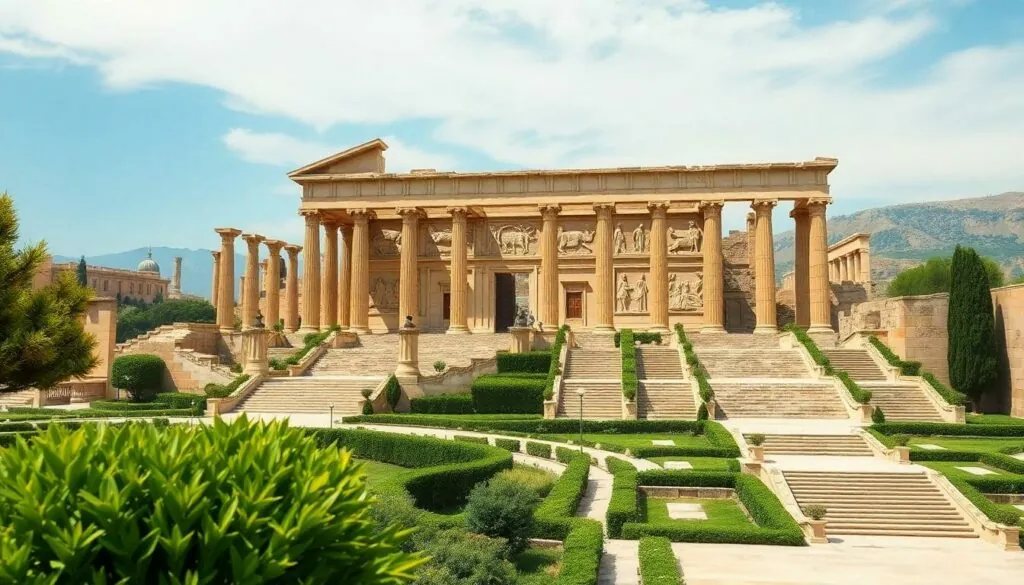Table of Contents
ToggleWhen it comes to ancient civilizations, few can rival the grandeur of Persian architecture. Picture towering columns, intricate reliefs, and sprawling palaces that could make even modern-day architects green with envy. This isn’t just about bricks and mortar; it’s a testament to a culture that knew how to blend functionality with jaw-dropping beauty.
Overview of Ancient Persian Architecture
Ancient Persian architecture showcases a wealth of breathtaking designs that date back to the Achaemenid Empire. Towering columns, often adorned with intricate reliefs, demonstrate both engineering prowess and artistry. Noteworthy examples include palaces such as Persepolis, where grand staircases and expansive courtyards exemplify the civilization’s grandeur.
Stone carving played a significant role in Persian architecture, with artisans skillfully creating detailed friezes and motifs. Reliefs depict scenes of royal ceremonies, battles, and deities, conveying the power and beliefs of ancient Persia. Additionally, structures often feature monumental gateways, known as “izzar,” which served as entry points to important sites.
Use of materials like limestone and mudbrick facilitated the construction of durable buildings designed to withstand time. Architectural innovations included impressive archways and domes, reflecting influences from various cultures encountered through trade and conquest. Gardens often accompanied these structures, incorporating water features and pathways to enhance tranquility and beauty.
Architectural styles evolved over centuries, with influences from neighboring regions such as Mesopotamia and Egypt. The Sassanian period introduced new elements, including more elongated and complex forms. Each era contributed to the richness of Persian architecture, highlighting both local traditions and external inspirations.
Thus, ancient Persian architecture serves as a testament to the civilization’s cultural depth and artistic achievements. It represents a confluence of functionality and beauty, leaving a lasting legacy that continues to inspire contemporary designs.
Key Features of Ancient Persian Architecture

Ancient Persian architecture showcases several remarkable features that exemplify the civilization’s artistic and engineering prowess. Key elements highlight the grandeur and sophistication of this architectural style.
Use of Columns and Pillars
Columns and pillars play a pivotal role in ancient Persian architecture, supporting massive structures while adding to their aesthetic appeal. Monumental columns often reached impressive heights, contributing to the sense of grandeur associated with buildings like Persepolis. Distinctive capitals, frequently adorned with floral and animal motifs, enhanced their visual interest. These columns created grand spaces that invited admiration from visitors. Furthermore, the innovative use of hypostyle halls, where rows of columns provided shade and support, allowed for large gatherings.
Grand Entrances and Portals
Grand entrances and portals served as striking entry points to monumental sites, embodying the authority of the Persian Empire. These impressive gateways, known as “izzar,” often featured intricate carvings that depicted scenes of royal significance and divine protection. Decorative elements included reliefs of mythical creatures like griffins, emphasizing the link between the earthly realm and the divine. Visitors often encountered these grand portals before entering vast courtyards and ceremonial spaces, fostering a sense of anticipation and awe. The scale and craftsmanship of these entrances exemplified the advanced architectural practices of the time.
Major Examples of Ancient Persian Architecture
Ancient Persian architecture showcases remarkable design and functionality. Key structures from two significant periods highlight this architectural prowess.
The Achaemenid Empire
Persepolis stands as a prime example of Achaemenid architecture. Constructed in the 6th century BCE, this ceremonial capital features grand staircases and expansive courtyards. Monumental columns adorned with intricate floral motifs support its impressive structures. The Apadana, a large audience hall, exemplifies the use of hypostyle design, allowing gatherings beneath a shaded area. The detailed friezes depict royal ceremonies, seamlessly blending art with purpose. Overall, the Achaemenid architectural style reflects the empire’s power and cultural depth.
The Sasanian Period
The Sasanian era introduced innovative architectural techniques. Notable constructions like the Palace of Ardashir demonstrate large vaulted spaces, highlighting advances in dome construction. Stone and brick materials ensured durability and stability. The use of large arcs often created vast interiors suitable for gatherings. Additionally, palaces showcased intricate tile work, combined with expansive gardens, contributing to aesthetic appeal. The Sasanian architecture influenced subsequent architectural developments, presenting a fusion of form and function.
Influences on Ancient Persian Architecture
Ancient Persian architecture drew inspiration from various cultures and civilizations, intertwining styles and techniques. Mesopotamian and Egyptian influences are evident in monumental scale and decorative elements. The use of monumental gateways, inspired by earlier cultures, served to symbolize power and grandeur. Additionally, elements such as columns with floral motifs reflect the aesthetic preferences of surrounding regions.
Cultural exchanges through trade significantly contributed to architectural development. Notable interactions with Greek and Indian civilizations introduced new design philosophies and materials. The incorporation of statuary and friezes, resembling styles from these cultures, enriched Persian architecture’s visual narrative. Persian artisans adeptly combined these elements, resulting in structures that conveyed both authority and beauty.
Architectural techniques advanced markedly during the Achaemenid Empire due to influence from conquering regions. Use of the hypostyle hall design allowed for expansive gathering spaces, enhancing social functions. Furthermore, innovations such as arch construction emerged from interaction with adjacent civilizations, facilitating larger and more stable structures.
The Sasanian Period marked another era of architectural evolution, showcasing interregional influences. Structures like the Palace of Ardashir reflected advancements in dome design, drawing inspiration from earlier Persian styles and external traditions. Elaborate tile work became a hallmark, adding vibrant detail that indicated a merging of functionality and artistry.
Gardens played a significant role in shaping the architectural landscape. Persian gardens, often integrated with structures, emphasized tranquility and aesthetic pleasure. The careful layout of these gardens adopted principles from earlier horticultural practices, showcasing a continuity of design preferences across centuries.
Ancient Persian architecture remains a remarkable testament to the ingenuity and artistry of its creators. Its monumental structures and intricate designs reflect a civilization that valued both beauty and functionality. The blend of diverse influences and innovative techniques resulted in architectural marvels that not only served practical purposes but also conveyed cultural significance.
As modern architects draw inspiration from these ancient designs, the legacy of Persian architecture continues to resonate. Its ability to harmonize nature and built environments highlights a timeless approach to design that remains relevant today. The enduring appeal of these structures invites admiration and exploration, ensuring that the brilliance of ancient Persia is never forgotten.







